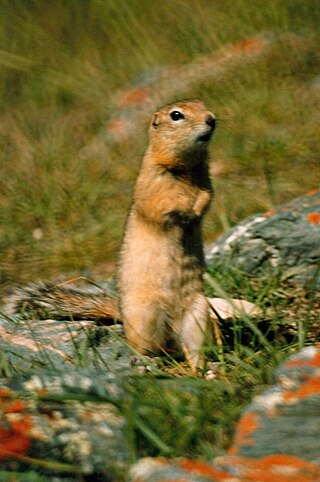
Chipmunks are small, striped rodents of Sciuridae, the squirrel family; specifically, they are ground squirrels (Marmotini). Chipmunks are found in North America, with the exception of the Siberian chipmunk which is found primarily in Asia.

The ferruginous hawk is a large bird of prey and belongs to the broad-winged buteo hawks. An old colloquial name is ferrugineous rough-leg, due to its similarity to the closely related rough-legged hawk.

The northern Idaho ground squirrel is a species of the largest genus of ground squirrels. This species and the Southern Idaho ground squirrel were previously considered conspecific, together called the Idaho ground squirrel.

John Kirk Townsend was an American naturalist, ornithologist and collector.

Richardson's ground squirrel, also known as the dakrat or flickertail, is a North American ground squirrel in the genus Urocitellus. Like a number of other ground squirrels, they are sometimes called prairie dogs or gophers, though the latter name belongs more strictly to the pocket gophers of family Geomyidae, and the former to members of the genus Cynomys.

The Washington ground squirrel is near threatened species of squirrel distributed in the Pacific Northwest states of Washington and Oregon, United States.

The gray-tailed vole also known as the gray-tailed meadow vole or gray-tailed meadow mouse, is a rodent in the genus Microtus of the family Cricetidae. Voles are small mammals, and this species lies roughly in the middle of their size range. First collected in 1895, it is endemic to the Willamette Valley, Oregon, and Clark County, Washington, in the Pacific Northwest region of North America. Historically, they were found in the prairie areas of the Valley and, though many of these areas have been converted for agricultural purposes, these animals remain common. For reasons that remain unclear, vole population densities in any area may fluctuate widely from season to season and year to year. They are preyed upon by owls, hawks, and carnivorous mammals, and their parasites include fleas and ticks. These voles build burrows and complex tunnel networks, which they sometimes share with other burrowing animals. Relatively little is known about their behavior in the wild, because they are elusive and unlikely to enter traps.

The Uinta ground squirrel, commonly called a "chisler" and Potgut in northern Utah, is a species of rodent native to the western United States.

Townsend's vole is a species of rodent in the family Cricetidae, the sister species of M. canicaudus. It is found in temperate grasslands of British Columbia in Canada and in the states of Washington and Oregon in the United States.

Merriam's ground squirrel is a species of rodent in the family Sciuridae. It occurs in the western United States in Idaho, Nevada, and Oregon.

The Columbian ground squirrel is a species of rodent common in certain regions of Canada and the northwestern United States. It is the second largest member of the genus Urocitellus, which is part of the tribe Marmotini, along with marmots, chipmunks, prairie dogs, and other holarctic ground squirrels. They are stout, with short dense fur, which is characteristically tawny across the bridge of the nose. Social encounters sometimes are initiated with kissing behavior and the most common activity above ground is standing at attention. Residing in mountainous terrain and high plains in northern latitudes, they hibernate for 8 to 9 months of the year in burrows, which may be used for many years. They are emaciated when emerging in the spring. The Columbian ground squirrel came to the attention of the scientific community through writings produced by Lewis and Clark, while 21st century molecular genetics has more finely illuminated its ties with other close relatives.

The Wyoming ground squirrel is a species of rodent in the family Sciuridae. It is endemic to the Northwestern United States.

The speckled ground squirrel or spotted souslik is a species of rodent in the family Sciuridae from Eastern Europe. Spermophilus suslicus consists of three subspecies: S. s. boristhenicus, S. s. guttatus, and S. s. suslicus. It is threatened by habitat loss.

The long-tailed ground squirrel or Eversmann's souslik is a species of rodent in the squirrel family Sciuridae. It is found in China, Kazakhstan, Mongolia, and Russia.

Urocitellus is a genus of ground squirrels. They were previously believed to belong to the much larger genus Spermophilus, but DNA sequencing of the cytochrome b gene showed that this group was paraphyletic to the prairie dogs and marmots, and could therefore no longer be retained as a single genus. As a result, Urocitellus is now considered as a genus in its own right.

The southern Idaho ground squirrel is a species of the largest genus of ground squirrels. This species and the Northern Idaho ground squirrel were previously considered conspecific, together called the Idaho ground squirrel.

















